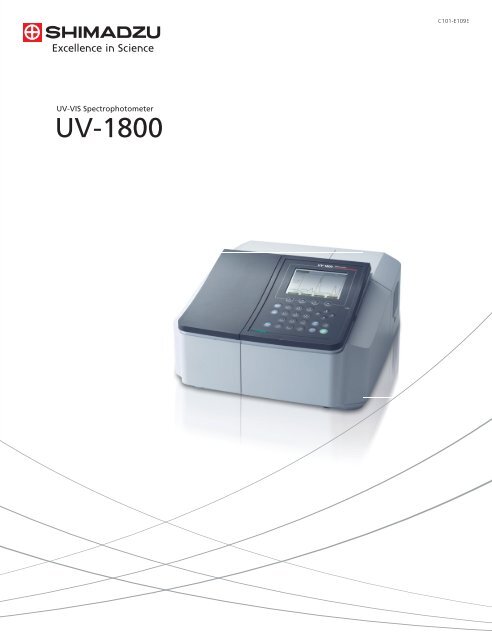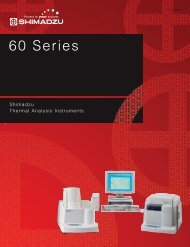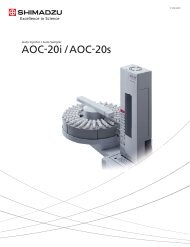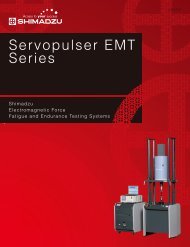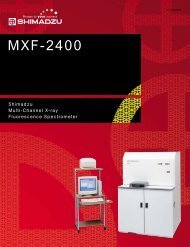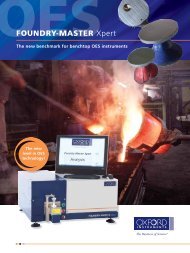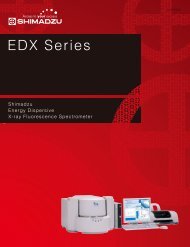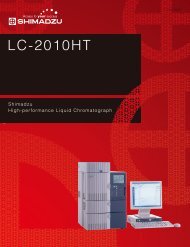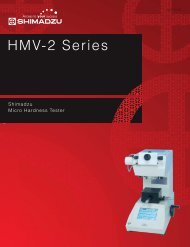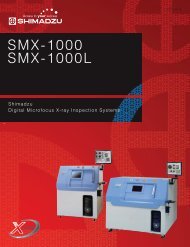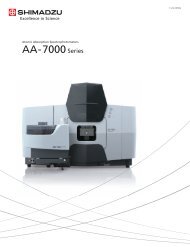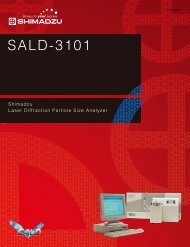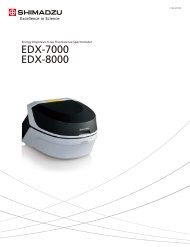UV-1800
UV-1800
UV-1800
Create successful ePaper yourself
Turn your PDF publications into a flip-book with our unique Google optimized e-Paper software.
<strong>UV</strong>-VIS Spectrophotometer<strong>UV</strong>-<strong>1800</strong>C101-E109E
<strong>UV</strong>-<strong>1800</strong><strong>UV</strong>-VIS SpectrophotometerContentsHighest resolution (1 nm)Space-saving designUSB memory readyGreater operabilityVariety of measurement modesControl with <strong>UV</strong>Probe SoftwareAccessoriesSpecificationsP. 4P. 6P. 8P. 10P. 12P. 14P. 16P. 24
High resolutionResolution of 1 nm is best in its classSpace reductionsSmall installation area: 450 (W) × 490 (D) mmImproved operabilityEquipped with USB terminalA compact, double-beam <strong>UV</strong>-VIS spectrophotometer wrapped in a sleek form.The <strong>UV</strong>-<strong>1800</strong> uses the Czerny-Turner mounting for its monochromator, and boasts the highestresolution in its class*, a bright optical system, and a compact design.Available as either a stand-alone instrument or a PC-controlled instrument, the <strong>UV</strong>-<strong>1800</strong> isUSB-memory ready, which enables users to save measurement data to highly versatile USBmemory, and perform data analysis and printing using a PC.*As of March 2007, according to Shimadzu research.
Highest resolution in its class - 1 nmIn addition to achieving a resolution of 1 nm, the highest in its class, by using amonochromator with a Czerny-Turner mounting, the <strong>UV</strong>-<strong>1800</strong> also features acompact, bright optical system. Having a resolution of 1 nm makes it easy tosatisfy the standards of wavelength resolution demanded by the EuropeanPharmacopoeia. The <strong>UV</strong>-<strong>1800</strong> also conforms to the specifications demanded bythe Japanese Pharmacopoeia in relation to wavelength accuracy andphotometric accuracy. Additionally, hardware validation based on theJapanese Pharmacopoeia can be performed using validation software that isincorporated as a standard feature and an optical filter for wavelengthcalibration that is calibrated at a bandwidth of 1 nm.4
The wavelength accuracy can be checked precisely using anoptical filter designed for this purpose.The spectrum and peak detection results obtained for NIST SRM 2034 Holmium Oxide Solution which is used as a wavelength standard,are shown below.Highest resolution1 nmT%100806040200220 270 320 370 420 470 520 570 620 670nmWavelength(nm)640.55536.55485.25467.80416.15385.55361.20345.35333.45287.15278.00249.85241.00Spectrum of Benzene/Ethanol SolutionBenzene exhibits a sharp absorption waveform in the neighborhoodof 250 nm. With such a waveform, there is a large differencebetween the spectra obtained at resolutions of 1 nm and 2 nm.Spectra obtained for benzene/ethanol solution using the <strong>UV</strong>-<strong>1800</strong>and an instrument with a resolution (bandwidth) of 2 nm are shownbelow. Due to the difference in resolution, differences in peakintensity of up to 40% can be observed.Spectrum of Toluene/Hexane SolutionUsing the ratio of the peak value obtained in the neighborhood of269 nm for toluene/hexane solution and the valley value obtained inthe neighborhood of 266 nm as an indicator of resolution, theEuropean Pharmacopoeia demands a ratio more than 1.5. The ratiofor the spectrum shown below is 1.94, illustrating the ease withwhich the <strong>UV</strong>-<strong>1800</strong> satisfies the standards of wavelength resolutiondemanded by the European Pharmacopoeia.Red line: <strong>UV</strong>-<strong>1800</strong> (resolution: 1 nm)Blue line: Instrument of resolution (bandwidth) 2 nm1.81.61.40.50.4Red line: <strong>UV</strong>-<strong>1800</strong> (resolution: 1 nm)Abs.1.21.00.80.6Abs.0.30.20.40.10.20.0230 240 250 260 270 280nm0.0265 270 275nm<strong>UV</strong>-<strong>1800</strong><strong>UV</strong>-VIS Spectrophotometer5
Space-saving designThe width of the <strong>UV</strong>-<strong>1800</strong> is 450 mm, making it one of the most compactinstruments in its class. This allows installation in tight spaces. Open up thelast two pages of this catalog to get a better idea of the dimensions.6
<strong>UV</strong>Probe PC software (provided as standard)makes data processing easy.<strong>UV</strong>ProbeUSB memory + PC + <strong>UV</strong>Probe (provided as standard)Using <strong>UV</strong>Probe control/data processing PC software makes it possible to directly read data thatis transferred to the PC.<strong>UV</strong>ProbeAn all-in-one software product that has the following four functions:Spectrum modePhotometric mode (including quantitation)Kinetics mode (time-course measurement of photometric values and enzymatic activityoperations)Report Generator (printing and creation of printing template)USB memory ready<strong>UV</strong>ProbeUSB memory + PC + <strong>UV</strong>Probe (provided as standard) + PrinterSpectra and data can be freely combined and arranged.The thickness and color of spectral lines and the size of characters can be setfreely.Labels can be attached to spectra.Registering layouts as templates allows reportsto be printed with a single operation.Data can be read with commercial spreadsheet software.With the <strong>UV</strong>-<strong>1800</strong>, the curve-related data (spectra and time-course curves) that are obtainedcan be converted to, and saved in, CSV format. Transferring this data with USB memory allowsit to be read directly at a PC using commercial spreadsheet software.*The above spectrum was created with Microsoft ®Excel graph functions after the data was read.(Example of reading using Microsoft ® Excel)<strong>UV</strong>-<strong>1800</strong><strong>UV</strong>-VIS Spectrophotometer9
The functions available with earlier instrumentshave been improved to give greater operabilityPrinting is possible using a greater number of printers.<strong>UV</strong>-<strong>1800</strong> + MPU screen copy printer (option)Prints hard copies of screens and numerical data. The items displayed onthe screen, such as spectra and calibration curves, can be printed.<strong>UV</strong>-<strong>1800</strong> + Commercial printer (option)Printing is possible to printers that support ESC/P-9,ESC/P-24, ESC/P Raster, and PCL control codes.10
New Function Security functions have been improved.Enabling the <strong>UV</strong>-<strong>1800</strong> security functionsmakes it possible to restrict functionsaccording to the user level.Users can log in as:AdministratorDeveloperOperatorThree different authorization levels can be setin accordance with these user classifications.Greater operabilityInstrument validation and maintenance/inspection functionshave been enhanced.Instrument Validation FunctionsThe checks for nine JIS items can be performed automatically orsemi-automatically.The stray-light check performed using aqueous potassium chloride(KCl) solution and the resolution check performed usingtoluene/hexane solution specified by the European Pharmacopoeiaare possible.Linking with a 6-series multi-cell (optional) is possible, makingsample replacement unnecessary. Inspections can be performedefficiently.Instrument Maintenance and InspectionsThe usage times of the deuterium (D2) lamp and the halogen (WI) lamp can be recorded anddisplayed, which enables users to ascertain the expected replacement period of the lampswhen performing periodic inspections.<strong>UV</strong>-<strong>1800</strong><strong>UV</strong>-VIS Spectrophotometer11
From photometric to protein quantitation:Equipped with a variety of measurement modesas a standard feature1. Photometric ModeMeasures the absorbance or transmittance at a single wavelength ormultiple (up to eight) wavelengths. In multiple-wavelengthmeasurement, calculations can be performed on the data obtainedfor up to four wavelengths, including the calculation of the differencebetween, or ratio of, the measurements obtained for twowavelengths.2. Spectrum ModeA sample spectrum is recorded using wavelength scanning. Repeatscans let you follow sample changes over time. Zoom in on thefinished spectrum for a better view, then use the peak/valley pickfunction to select maxima and minima, and perform a wide variety ofdata processing functions.3. Quantitation ModeGenerates a calibration curve from the measurement of standards,and then calculates the concentrations of unknowns. Allows variouscombinations of wavelength number (1 to 3 wavelengths andderivatives) and calibration curves (K-factor and first-to-third order).12
4. Kinetics ModeMeasures absorbance changes as a function of time, and obtains theenzymatic activity values. The kinetics measurement method or therate measurement method can be selected. When using theMMC-1600/1600C Multi-Cell Holder (8/16 cells) or the CPS-100 CellPositioner (6 cells), multiple samples can be measured at the sametime.5. Time Scan ModeMeasures the change in absorbance, transmittance or energy as a function of time. When using the MMC-1600/1600C Multi-Cell Holder (8/16cells) or the CPS-100 Cell Positioner (6 cells), multiple samples can be measured at the same time.6. Multi-Component Quantitation ModeQuantitates up to eight components mixed in a single sample. The calibration equation is determined using pure or mixed components withknown values.Variety ofmeasurement modes7. Biomethod ModeCapable of determining DNA and protein concentrations using thefollowing quantitation methods.DNA/Protein QuantitationQuantitates DNA or protein using the absorbance at 260/230 nm or260/280 nm.Protein QuantitationLowry methodBCA method (method using Bicinchoninic Acid)CBB method (method using Coomassie Brilliant Blue G-250)Biuret method<strong>UV</strong> Absorption method (direct measurement at 280 nm)<strong>UV</strong>-<strong>1800</strong><strong>UV</strong>-VIS Spectrophotometer13
Control with <strong>UV</strong>Probe softwareUsing the <strong>UV</strong>Probe software provided makes it possible to control the<strong>UV</strong>-<strong>1800</strong> with a PC. <strong>UV</strong>Probe is an all-in-one software product thatincludes the following four functions: Spectrum mode, Photometric(quantitation) mode, Kinetics (time-course) mode, and a superbReport Generator.(A USB cable is required for connection to the PC.)A Variety of Data Processing and Calculation FunctionsData processing operations, such as peak detection and area calculation, and data conversion operations, such as integration andinterpolation, can be applied to spectra and time-course data.With the kinetics module, the Michaelis constant (Km) or the maximum response speed (Vmax) can be calculated and plotted.Calculation Expressions and QA/QC FunctionsWith the photometric module, calculation expressions can be defined for measurement results.Judgment expressions can be created for photometric values and calculation results.14
GLP/GMP CompliantGLP/GMP compliance is supported with the following functions.Security FunctionsThe use of functions can be restricted according to the user level.Audit Trail FunctionDetails of processes (e.g., baseline correction) that affect measurement data are tracked in theinstrument’s history.Data History FunctionIf a change is made to measurement data, a history of this is added to the data.Operating SystemMeasurement ModesGeneralSpectrum ModeData Processing in Spectrum ModePhotometric (Quantitation) ModeKinetics (Time-Course Measurement) ModeReport GeneratorWindows 7 ProfessionalSpectrum, Kinetics (time-course measurement), Photometrics (quantitation)Multitasking (simultaneous measurement and data processing, and other types of processing)Customizable measurement screen layout (wavelengths, data display font and font size, colors, displayed number of rows)GLP/GMP compliant (security, history)Comparison of multiple spectra /relative processing *Spectrum enlargement/shrinking, auto scale and Undo/Redo of these operationsAnnotation on spectrum screenNormalization, Point Pick, peak/valley detection, area calculationTransformations: 1st to 4th order derivatives, smoothing, reciprocal, square root, natural log, Abs. to %Tconversion, exponential conversion, Kubelka-Munk conversionEnsemble averaging, interpolation, data set and constants arithmetic (between spectra, between spectra and constants)Single wavelengths, multi wavelengths (includes 1, 2, or 3 wavelengths), and spectrum quantitation (peak,maximum values, area, etc. for specified wavelength ranges)K-factor, single-point calibration curve, and multiple-point calibration curve (1st, 2nd, 3rd order function fitting,pass-through-zero specification)Photometric processing with user-defined functions (+, -, ×, ÷, Log, and Exp, etc. functions, including factors)Weight correction, dilution factor correction, and other types of factor-based correction for each sampleAveraging of repeat measurement dataSimultaneous display of standard table, unknown table and calibration curvesDisplay of Pass/Fail indications based on measurement resultsComparison/relative data processing of multiple time-course data*Single or double wavelength measurement (difference or ratio)Simultaneous display of time-course data (curves and measurement data), Michaelis-Menten table, and graphsEnzyme kinetics calculations (for single cells or multi-cells)Michaelis-Menten calculations and graph creation (Michaelis-Menten, Lineweaver-Burk, Hanes, Woolf,Eadie-Hofstee), Dixon plot, Hill plotData processing (corresponds to spectrum data processing)Layout and editing of printing templatesQuick printing using report templatesInsert date, time, text, and drawing objects including lines, circles and rectanglesControl with<strong>UV</strong>Probe Software*Depends on the PC environment (e.g., memory). As a rough guide, 20 to 30 sets of spectral data can be handled.<strong>UV</strong>-<strong>1800</strong><strong>UV</strong>-VIS Spectrophotometer15
AccessoriesConstant-Temperature Cell Holder (P/N 202-30858-04)Maintains a sample cell and reference cell at a desired, uniformtemperature, by circulating constant-temperature water.Temperature range: 5°C to 90°C(depends on the performance of the constant-temperature water circulator)Cell holder: Accepts a pair of 10-mm square cells.Connecting joint outer diameter: 6 mm and 9 mm (two levels)Constant-Temperature Four-Cell Holder (P/N 204-27206-02)Maintains four sample cells and a reference cell at a desired, uniformtemperature, by circulating constant-temperature water.Temperature range: 5°C to 90°C(depends on the performance of the constant-temperature water circulator)Cell holder: Accepts four 10-mm square cells plus a reference cellConnecting joint outer diameter: 9 mmNote: The Four-Cell Sample Compartment Unit (P/N 206-23670-91) is necessary.CPS-100 Cell Positioner, Thermoelectrically Temperature Controlled (P/N 206-29500-**)This attachment permits measurement of up to six sample cells underconstant-temperature conditions. Combination of this attachment andthe Kinetics mode provides measurement of temperature-sensitiveenzyme kinetics of one to six samples.Number of cells: 6 on the sample side (temperature-controlled)1 on the reference side (temperature not controlled)Temperature control range: 16°C to 60°CTemperature display accuracy (difference from the true value): ± 0.5°CTemperature control precision (variation of temperature): ± 0.1°CAmbient temperature: 15°C to 35°CNote: Square cells (P/N 200-34442) are not included, please purchase separately.A USB adapter CPS (P/N 206-25234-91) is required.TCC-100 Thermoelectrically Temperature Controlled Cell Holder (P/N 206-29510-**)Uses Peltier effect for controlling the sample and referencetemperature, so no thermostated bath or cooling water is required.Number of cells: One each on the sample and reference sides (temperature-controlled)Temperature control range: 7°C to 60°CTemperature display accuracy (difference from the true value): ± 0.5°CTemperature control precision (variation of temperature): ± 0.1°CNote: Square cells (P/N 200-34442) are not included, please purchase separately.18
S-1700 Thermoelectric Single-Cell Holder (P/N 206-23900-**)This cell holder permits setting of a temperature program to increase anddecrease the sample cell temperature.The thermoelectric system allows prompt control of sample temperature between 0°C and 110°C.Temperature increase/decrease speed can be changed using 12 settings, which means theholder can be used in analysis of melting curves for nucleic acids, etc., that occur duringquick as well as slow heating (or cooling).A stirrer is also provided to ensure uniform temperature distribution throughout the cell.Cooling water circulation is required for Peltier element cooling. And though tap water can be used,it is recommended that a commercially available constant-temperature water circulator be used, asthe following conditions must be fulfilled to exact maximum performance from the S-1700.Cooling water specification: 20 ± 2°CWater flow: 4.8 L/min min or more.Temperature is not controlled at the reference side.Cells are not supplied.Type Optical Path Length Minimum Sample Volume Required Please use 10-mm square110-QS-10 10 mm3.5 mLtight-sealing cells (a Hellma product).115B-QS-10 10 mm400 μLTemperature accuracy in cell (when room temperature is 25°C):Within 0.25°C (0°C to 25°C)Within ± 1% of set value (25°C to 75°C)Within ± 2% of set value (75°C to 110°C)Tm Analysis System TMSPC-8 (P/N 206-24350-91)This system obtains a temperature-versus-absorbance curve data, and the Tm AnalysisSoftware analyzes the Tm (melting temperature) of nucleic acids such as DNA and RNA. Thesystem consists of an 8 Series Micro Multi-Cell Holder, Tm Analysis Software, and TemperatureController. 8 Series Micro Cells, Silicone Cap, and Constant-Temperature Water Circulator forprotecting peltier device are not included. Please purchase separately.Description8 Series Micro Cell Optical Path 10 mm, Sample Volume 100 μL8 Series Micro Cell Optical Path 1 mm, Sample Volume 35 μLSilicone Cap for Micro Cell (24 pcs)Temperature control range: 0.0 to 10.0°CTm Calculation mode: Average Method, Differential MethodOS: Windows 7 ProfessionalP/N208-92097-11208-92140206-57299-91Note: Please purchase the constant-water circulator which fulfills specifications below.Temperature range: 20 ± 2°C, Flow rate: 4.8 L/min or moreInner diameter of the connecting pipe: ø8, 10, 12 mmNTT-2200P Constant-Temperature Water Circulator (P/N 208-97263)Circulates temperature-controlled water to a constant-temperature cell holder.Temperature range: Ambient +15°C to 80°CTemperature control precision: ± 0.05°C or moreMaximum pumping rate: 27/31 L/min, 9.5/13 m (50/60 Hz)External circulation nozzle: 10.5 mm OD (both outlet and return)Tank capacity: About 10 L (9 L during use)Safety features: Detection of over-temperature of Upper or Lower limits,Detection of heater wire malfunction, Protection from heatingtoo little circulating water, Detection of sensor malfunction,Independent over-heat protection, Over-current circuit protectorStandard accessories: Lid with handles, Rubber hose (4 m; inner diameter: 8 mm;outer diameter: 12 mm; quantity: 1), Hose clamps (4pc),instruction manual (Japanese and English)Dimensions: 270 (W) × 560 (H) × 400 (D) mmPower requirements: 100 VAC, 1,250 VA, with 1.7-m power cord and grounded plug<strong>UV</strong>-<strong>1800</strong><strong>UV</strong>-VIS Spectrophotometer19Accessories
AccessoriesModelSipper Unit 160L (Standard Sipper)Sipper Unit 160T (Triple-Pass Sipper)Sipper Unit 160C (Constant-Temperature Sipper)Sipper Unit 160U (Supermicro Sipper)P/N206-23790-91206-23790-92206-23790-93206-23790-94Standard Sample Volume2.0 mL1.5 mL2.5 mL0.5 mLFour types of sipper units with different flow cell types are available. The steppingmotor-driven peristaltic pump ensures reliable and smooth aspiration of samplesolution.(Direct driving is possible from the <strong>UV</strong>-<strong>1800</strong> so no interface is required.)Note: The use of a Solenoid Valve (Fluoropolymer) (P/N 204-06599-01) andthe SWA-2 Sample Waste Unit (206-23820-91) are recommendedwhen strong acids, strong alkalis, or organic solvents are to be measured.Syringe SipperModelP/NSyringe Sipper N (Normal temperature type)206-23890-91Syringe Sipper CN (Constant temperature, water circulator type) 206-23890-92The sipper unit employs a syringe-pump system. The liquid-contact surfaces arecomposed of Fluoropolymer, glass, or quartz, imparting excellent chemical resistanceand ease of maintenance, and allowing measurement of almost any sample type.Further, the extremely high repeatability of sipping volume (repeat precision: ± 0.03mL) makes it ideal when performance validation is required.Note: Flow cell available separately. Choose from the recommended flow cells listed below.Recommended Flow CellsCell Type P/N Optical Path Length Dimensions of ApertureSquare (ultra-micro) 208-92114 10 mmø2 mmSquare (micro) 208-92113 10 mmø3 mmSquare (semi-micro) 208-92005 10 mm 11 (H) 3.5 (W) mmStandard Required Sample Volume0.9 mL1.0 mL5.0 mLThe type of flow cell can be selected in accordance with the application.The flow cell can be changed independently for excellent ease of maintenance.Circulated-water temperature range: ambient to 60°C (CN type)Note: If a square flow cell (micro or supermicro) is used, attaching mask R (206-88679)to the reference cell holder is recommended to balance the light intensity.ASC-5 Auto Sample Changer (P/N 206-23810-**)Combine with a Sipper 160 to build an automated multisample spectrophotometrysystem.The aspirating nozzle is programmed to move in the X, Y, and Z (vertical) directions.Up to 8 sets of operational parameters, including the sizes of racks and the numbersof test tubes, may be memorized in the battery back-up protected files.Up to 100 test tubes may be set together on the rack.Note: An ASC USB adapter (P/N 206-25235-91) is required.Note: A commercially available test tube stand, with a footprintsmaller than 220 220 mm, is applicable.20
Micro Flow CellUsed for the continuous analysis of samples such as the liquids produced by column chromatography.Model P/N Optical Path Length Volume10-mm Micro Flow-thru Cell with Holder5-mm Micro Flow-thru Cell with Holder204-06222204-06222-0110 mm5 mm0.3 mL0.15 mLInner diameter of tube: 1 or 2 mmFront Panel with Holes (P/N 204-27588-03)Allows the tubes of a flow cell, for example, to be connected through the front panelof the instrument.Flow-Thru Cell for HPLC (P/N 206-12852)With this flow-thru cell attached, the spectrophotometer can be used as avariable-wavelength <strong>UV</strong>-VIS detector for an HPLC system.Inner diameter: 1 mm; Optical path length: 10 mm; Inner volume: 8 µLFlow-thru cell on the sample side and cell holder with a mask on the reference side.SUS tube: Outer diameter: 1.6 mm; Inner diameter: 0.3 mmSpecular Reflectance Measurement Attachment (5°Incident Angle) (P/N 206-14046)The technique of specular reflectance measurement is often applied to theexamination of semiconductors, optical materials, multiple layers, etc., relative to areference reflecting surface. The 5° incident angle minimizes the influence ofpolarized light. Thus, no polarizer is required in measurement ... the operation isquite simple.AccessoriesSamples as large as 100 (W) 160 (D) 15 (T) mm can be readily measured.The minimum size is 7 mm in diameter.Sample placement is easy - just set it on a holder with the measuring surface down.StructureOpticsSample(measuring surface down)Light beam<strong>UV</strong>-<strong>1800</strong><strong>UV</strong>-VIS Spectrophotometer21
Optional SoftwareOptional software that can be used when controlling operation from a PC<strong>UV</strong>Probe Agent Software (P/N 206-21550-92)The <strong>UV</strong>Probe Agent, which was developed for Shimadzu <strong>UV</strong>-VISspectrophotometers, is used to automatically transfer and store thevarious types of data acquired, or the results of performing dataprocessing with the <strong>UV</strong>Probe software, to a general-purpose database,and to perform operations related to high-security data managementand electronic signatures. This makes it possible for <strong>UV</strong>Probe to attaincompliance with FDA 21 CFR Part 11.The <strong>UV</strong>Probe Agent is network-compatible; therefore, by installingother Agent software for corresponding analytical instruments, such asHPLC or FTIR spectrophotometers, data from all analytical instrumentscan be integrally managed at a server PC and that data can bebrowsed at client PCs.Access Control and User ManagementAs with <strong>UV</strong>Probe, user access to the program is centrally managed by auser-authentication server without depending on the OS, enabling alevel of access control that complies with FDA 21 CFR Part 11. It is alsopossible to restrict the functions that can be executed by authenticatedusers on an individual basis, eliminating the possibility of unauthorizedusers making erroneous changes to settings.Security and Audit TrailsAll saved electronic records are stored and managed in a database,ensuring the original data is not lost when records are changed. Also,the contents of system usage records and records of changes made todata registered in the database are recorded together with the dateand the name of the person concerned.Data Integrity and Electronic SignaturesData is automatically stored in the database and is not deleted. Thedata stored in the database can be easily restored, allowing it to bedisplayed or reanalyzed as necessary. Also, electronic signatures can beapplied to electronically recorded data; this data is linked to analyticaldata, and the name of the signer, the date of the signature, and thereason for the signature are saved.AccessoriesApplicable OS: Windows 7 ProfessionalNote: <strong>UV</strong>Probe software Ver. 2.00 or a higher is required.Tm Analysis Software (P/N 206-57476-91)This software works with the S-1700 and accumulatestemperature-versus-absorbance curve data at the PC to analyze the Tm (meltingtemperature) of nucleic acids such as DNA and RNA. The right figure is a typicalsetup for this software.Applicable OS : Windows 7 ProfessionalNote: An RS-232C cable (P/N 200-86408) is needed to connect the PC to the S-1700.<strong>UV</strong>-<strong>1800</strong><strong>UV</strong>-VIS Spectrophotometer23
<strong>UV</strong>-<strong>1800</strong> SpecificationsItemSpecificationItemSpecificationWavelength range190 to 1,100 nmBaseline stabilityLess than 0.0003 Abs/Hr (700 nm,Spectral bandwidth1 nm (190 to 1,100 nm)one hour after light source turned ON)Wavelength display0.1 nm incrementsBaseline flatnessLess than ± 0.0006 Abs (1,100 to 190 nm,Wavelength setting0.1 nm incrementsone hour after light source turned ON)(1 nm increments when setting scanning range)Noise levelLess than 0.00005 Abs (700 nm)Wavelength accuracy± 0.1 nm at D2 peak 656.1 nm,Light source20-W halogen lamp and deuterium lamp± 0.3 nm for entire rangeBuilt-in light source auto position adjustmentWavelength repeatability± 0.1 nmMonochromatorBlazed holographic grating inWavelength slew rateAbout 6,000 nm/minCzerny-Turner mountingWavelength scanning speed3,000 to 2 nm/minDetectorSilicon photodiodeLamp interchange wavelengthAutomatic interchange linked to wavelength.Sample compartmentInternal dimensions: 110 (W) × 250 (D) × 115 (H) mmThe interchange wavelength can be set freely inDistance between light beams: 100 mmthe range of 295 to 364 nm (0.1 nm increments).Power requirementsAC100,120,220,230,240 V,Stray lightLess than 0.02% at 220 nm (NaI)50/60 Hz, 140 VALess than 0.02% at 340 nm (NaNO2)EnvironmentalTemperature: 15°C to 35°CLess than 1.0% at 198 nm (KCl)requirementsHumidity: 30% to 80%Photometric systemDouble beam optics(without condensation; 70% max. at 30°C or higher)Photometric rangeAbsorbance: -4 to 4 AbsDimensions450 (W) × 490 (D) × 270 (H) mmTransmittance: 0% to 400%Weight15 kgPhotometric accuracy± 0.002 Abs at 0.5 AbsOutput deviceUSB memory (optional)± 0.004 Abs at 1.0 AbsData files saved in text format or± 0.006 Abs at 2.0 Abs<strong>UV</strong>PC format.(measured using NIST930D/NIST1930 or equivalent.)<strong>UV</strong>PC-format files can be read directlyPhotometric repeatabilityLess than ± 0.001 Abs at 0.5 Absby <strong>UV</strong>Probe.Less than ± 0.001 Abs at 1 AbsPC compatibilityProvided with <strong>UV</strong>Probe software.Less than ± 0.003 Abs at 2 AbsExternal control possible via USB.24
<strong>UV</strong>-<strong>1800</strong> Software SpecificationsMeasurement modeSpecificationMeasurement modeSpecificationPhotometric modeSpectrum modeQuantitation modeKinetics modeTime scan modeMulti-componentquantitation modeSingle-wavelength measurement1.Photometric modes: T% or Abs2.Quantitation using K-factor method3.Data table storage and recall functionsMultiple-wavelength measurement1.Photometric modes: T% or ABS2.Measurements at up to eight designatedwavelengths (set in 0.1 mm increments)3.Data calculation at up to fourwavelengths (difference or ratio betweentwo wavelengths, calculation betweenthree wavelengths, etc.) is possible.1.Measurement modes: ABS, T%, E2.Number of repeat scans: 1 to 993.Recording system: Selection betweensingle spectrum and data overlay4.Data storage and recall5.Data processing:Peak/valley detection, arithmetic operations,differentiation, smoothing, area calculation,point picking, data reading atcursor-specified point1.Measurement methods:1-wavelength, 2-wavelength, 3-wavelength,and 1st to 4th derivative methods2.Quantitation methods:Automatic concentration calculation using K-factorAutomatic concentration calculation usingsingle-point calibration curveMulti-point calibration curve method(1st to 3rd order regression curves)3 Measurement parameters:Number of standards (2 to 10)Number of repeat measurements(1 to 10 times) to obtain a mean valuefor quantitation.1.Measures absorbance changes as a function oftime and calculates the enzymatic activity values.2.Measurement time: 1 to 9,999 sec/min3.Measurement methods: 1-wavelength,2-wavelength, multi-cell, and rate measurements1.Measures changes in measured values as a function of time.2.Measurement mode: ABS, T%, E3.Measurement time: 1 to 9,999 sec/min4.Data processing functions (same as spectrum mode)1.Up to eight components quantified at once.2.A mixture, as well as pure components, canbe used as a standard.3.Data on standards samples can be stored, inaddition to measurement wavelengths4.Quantitation of recalled spectrum data.Biomethod modeMaintenanceShared functionsDNA/Protein Quantitation1.Calculation of DNA/protein concentration and absorbance ratioDNA concentration = K1 × A1 - K2 × A2Protein concentration = K3 × A2 - K4 × A12.Factors and measurement wavelengths can be set freely.3.Background correction is possible.Quantitation of proteins1.Quantitation methods: Lowry method, BCA method, Biuretmethod, CBB method (Bradford method), <strong>UV</strong> method1.Baseline correction2.Lamp usage time display and reset.3.Security settingsFunctions can be restricted according to the user.4.Instrument validation functions:1) Compatible with 9 JIS itemsWavelength accuracy, wavelength repeatability,resolution, stray light, photometric accuracy,photometric repeatability, baseline flatness,baseline stability, noise level.2) Semi-automatic validationValidation inspections conducted interactivelywhile inserting and removing inspection jigs.3) Fully automatic validationAutomatic validation inspections from measurementto evaluation and printout.4) Setting inspection parameters and pass/fail criteriaAuthority to make changes can be protected bypassword access.5) Detailed printout of results6) Bulk printout of results1.Automatic setting of measurement modeafter instrument initialization.It’s possible to specify standby and parameterfiles in the parameter setting window for eachmeasurement mode.2.Selection of displayed number of decimal placesAbsorbance: 3 or 4 decimal placesTransmittance: 1 or 2 decimal places3.Number of files that can be saved (built-in memory)Measurement parameters: 24 files max.Data: 8 files max.Tabular data: 8 files max.4.Setting of integration time(for fixed-wavelength measurement)5.PC controlSpectrophotometer can be controlled by an external PC.This function is also used when performing operation withthe <strong>UV</strong>Probe software provided.*A USB cable is required.Specifications<strong>UV</strong>-<strong>1800</strong><strong>UV</strong>-VIS Spectrophotometer25
<strong>UV</strong>-<strong>1800</strong>450(W)270(H)490(D)SpecificationsCompany names, product/service names and logos used in this publication are trademarks and trade names of Shimadzu Corporation or itsaffiliates, whether or not they are used with trademark symbol “TM” or “®”.Third-party trademarks and trade names may be used in this publication to refer to either the entities or their products/services. Shimadzudisclaims any proprietary interest in trademarks and trade names other than its own.27www.shimadzu.com/an/For Research Use Only. Not for use in diagnostic procedures.The contents of this publication are provided to you “as is” without warranty of any kind, and are subject to change without notice. Shimadzudoes not assume any responsibility or liability for any damage, whether direct or indirect, relating to the use of this publication.© Shimadzu Corporation, 2013Printed in Japan 3655-10319-30AIT


